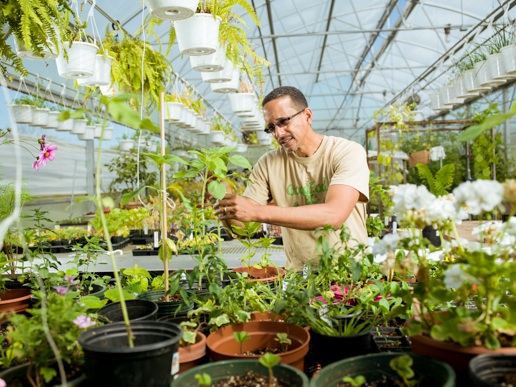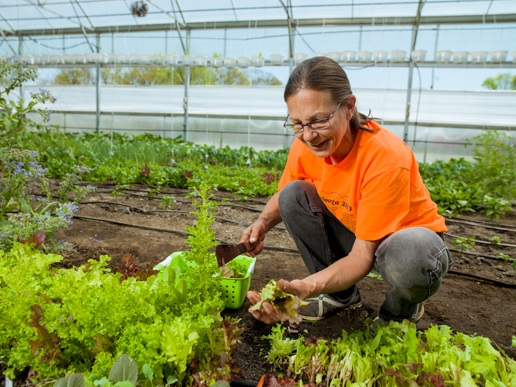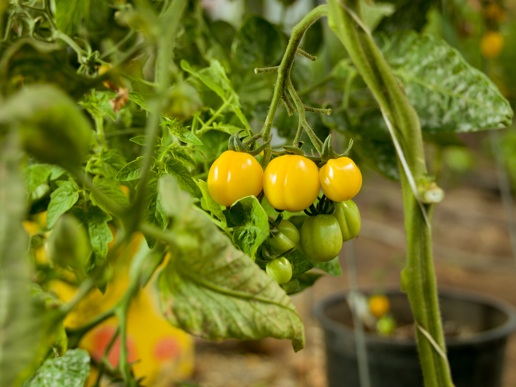How to Build an Equitable Food System: Lessons from Battle Creek
June 4, 2014
Source: Michigan NightLight
Author: Anya Zentmeyer
Good Food Battle Creek wants to improve access to healthy food by bringing residents, growers, nonprofits, and other concerned folks together to address challenges in the local food system.
If you really are what you eat, then what does it mean for a city where nearly one-third of residents lives in a food desert?
In Calhoun County, five U.S. Census Bureau tracts are classified as food deserts, which are places where residents have little to no access to fresh fruits and vegetables; they are all located in the Battle Creek area.
 “There is this huge disconnect between urban neighborhood development and making sure those communities have everything a resident would need for a good quality of life,” says Meredith Freeman, program director for Good Food Battle Creek and the larger Fair Food Network. “They might have a new, affordable home in those neighborhoods, but things like grocery stores, sit-down restaurants, and other types of retail are still missing.”
“There is this huge disconnect between urban neighborhood development and making sure those communities have everything a resident would need for a good quality of life,” says Meredith Freeman, program director for Good Food Battle Creek and the larger Fair Food Network. “They might have a new, affordable home in those neighborhoods, but things like grocery stores, sit-down restaurants, and other types of retail are still missing.”
Oddly, the food deserts are juxtaposed by 1,178 farms in Calhoun County. These account for 227,000 of the 453,000 total acres, or nearly half, of its geographical boundary.
“I think Battle Creek has a lot of opportunity,” Freeman says. “I think it really is just about being able to connect the dots, which we have done really well in the last few years. There’s lots of good stuff going on but it’s not connecting.”
That’s where Good Food Battle Creek, a group of individuals working together in support of the local food movement, comes in.

J.R. Reynolds, Good Food Battle Creek. Photo: Adam Bird.
“We all believe that our food system is broken, and so we are meeting in order to create greater cohesiveness among each other,” says J.R. Reynolds, GFBC coordinator and director of the Calhoun County Race Impact Alliance. The group networks with each other to help repair the local food system and to better inform and educate the community about food systems.
There is no formal membership to Good Food Battle Creek; it’s a myriad of voices around a table ranging from community members who grow their own food to Calhoun County officials to representatives from major manufacturers. GFBC awards about five small grants annually to different Battle Creek organizations doing food systems work. Grant funds come from the Fair Food Network, an organization based in Ann Arbor that receives its funding through the W.K. Kellogg Foundation.
Diversity around the table is important for a coalition working toward food equality, which includes socioeconomic considerations.
Rita Klavinski is a food systems expert with Michigan State University’s Center for Regional Food Systems; she connected with GFBC through MSU’s Extension program, which links educators and experts with community organizations. She says that income and access to healthy food are often correlated. Residents in low income or rural areas tend to have less resources – whether that means less grocery stores with fresh fruits and veggies or limited transportation to those grocery stores – or both.

Photo: Adam Bird
“People who have resources and people who have transportation really don’t think of that as being an issue for other people in their community,” says Klavinski. “Maybe they go into the gas station and see people buying food, but they don’t think, ‘Oh, gosh, that’s their dinner tonight.’ That probably never occurs to them.”
However, Freeman and Reynolds say there is another, prevailing factor that is even more central to any discussion "People who have resources and people who have transportation really don't think of that as being an issue for other people in their community," says Klavinski. "Maybe they go into the gas station and see people buying food, but they don't think, 'Oh, gosh, that's their dinner tonight.' That probably never occurs to them." surrounding food injustice or food inequality: race. Communities of color often have less stores carrying a good selection of healthy food.
These communities can be overrun with fast food restaurants, gas stations, and corner stores that charge high prices for nutritionally deficient, highly processed products.
According to a 2013 report issued by Calhoun County’s Public Health Department, one-third of the county’s African American population and 16 percent of its Hispanic population live within a designated food desert while only eight percent of non-Hispanic white residents do. That includes migrant workers, the majority of which are people of color.

Photo: Adam Bird
Within food systems, racism can often be institutionalized or systemic rather than directly focused on an individual. Educating both itself and the public on what racism means to not only the food system, but also society as a whole was a target focus identified by GFBC early on.
“Typically, when you think of racism, what you think of is the prejudice white person that, because of his hatred for a target group, is denying them opportunities,” Reynolds says.
“While that does exist on an individual level in certain spots of the food system, what’s happening is that the system itself is structurally racist by virtue of policies, procedures and an almost unconscious bias that exists as it is related to people of color,” says Reynolds.
A workshop series on racial equity held by GFBC last fall is a point of pride for the organization, along with the completion of a comprehensive Battle Creek Community Food Assessment, which includes information about Battle Creek’s agricultural
"…the system itself is structurally racist by virtue of policies, procedures and an almost unconscious bias that exists as it is related to people of color," says Reynolds.opportunities, access and affordability issues, and public health concerns, with input from various focus groups.
Focus group input for the Community Food Assessment revealed a number of individuals in Battle Creek who want to get involved with the local food system.
“That was probably the most surprising thing because as you go through life and walk Battle Creek, it doesn’t seem or feel like there are a lot of people paying attention to this sort of thing, but they are,” Reynolds said. Good Food Battle Creek was formed to help make those connections with the public and amongst those involved in the food system.
“All of the organizations that have been at the table from day one, and even some of the newer ones, are really committed to this work and to making sure that communities have access to good food, farmers have access to communities that need the food, and that we’re all working together to make that happen,” Freeman says.
First posted at Michigan NightLight on June 4, 2014.







